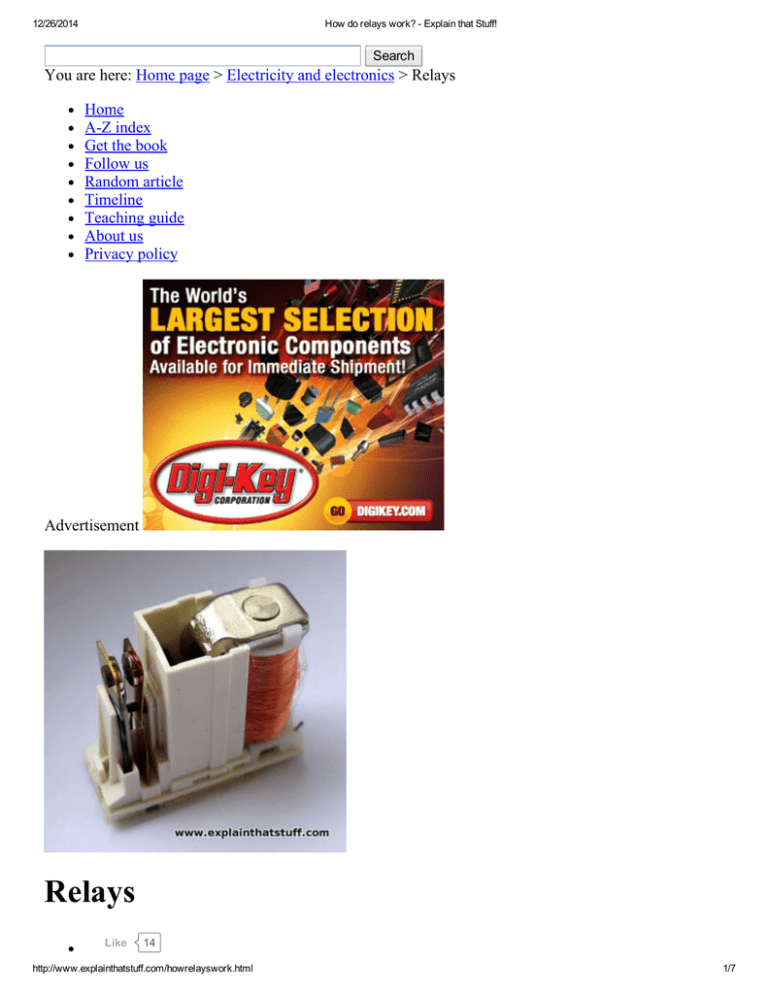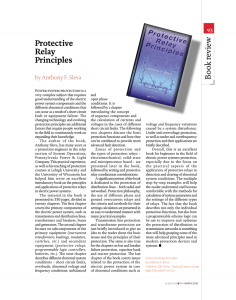
12/26/2014
How do relays work? ­ Explain that Stuff!
Search
You are here: Home page > Electricity and electronics > Relays
Home
A­Z index
Get the book
Follow us
Random article
Timeline
Teaching guide
About us
Privacy policy
Advertisement Relays
Like
14
http://www.explainthatstuff.com/howrelayswork.html
1/7
12/26/2014
How do relays work? ­ Explain that Stuff!
1
Tweet
0
by Chris Woodford. Last updated: March 28, 2014.
You might not realize it, but you're constantly on­guard, watching out for threats, ready to act at a
moment's notice. Millions of years of evolution have primed your brain to save your skin when the
slightest danger threatens your existence. If you're using a power tool, for example, and a tiny wood chip
flies toward your eye, one of your eyelashes will send a signal to your brain that make your eyelids
clamp shut in a flash—fast enough to protect your eyesight. What's happening here is that a tiny stimulus
is provoking a much bigger and more useful response. You can find the same trick at work in all kinds of
machines and electrical appliances, where sensors are ready to switch things on or off in a fraction of a
second using clever magnetic switches called relays. Let's take a closer look at how they work!
Photo: A typical relay with its plastic outer case removed. You can see the two spring contacts on the left
and the electromagnet coil (the red­brown copper­colored cylinder) on the right. In this relay, when a
current flows through the coil, it turns it into an electromagnet. The magnet pushes a switch to the left,
forcing the spring contacts together, and completing the circuit they're attached to. This is a relay from an
electronic, hot­water immersion heater programmer. The electronic circuit in the programmer switches
the magnet on or off at preprogrammed times of day using a relatively small current. That allows a very
much bigger current to flow through the spring contacts to power the element that heats the hot water.
What are relays?
A relay is an electromagnetic switch operated by a relatively small electric current that can turn on or off
a much larger electric current. The heart of a relay is an electromagnet (a coil of wire that becomes a
temporary magnet when electricity flows through it). You can think of a relay as a kind of electric lever:
switch it on with a tiny current and it switches on ("leverages") another appliance using a much bigger
current. Why is that useful? As the name suggests, many sensors are incredibly sensitive pieces of
electronic equipment and produce only small electric currents. But often we need them to drive bigger
pieces of apparatus that use bigger currents. Relays bridge the gap, making it possible for small currents
to activate larger ones. That means relays can work either as switches (turning things on and off) or as
amplifiers (converting small currents into larger ones).
How relays work
Here are two simple animations illustrating how relays use one circuit to switch on a second circuit.
http://www.explainthatstuff.com/howrelayswork.html
2/7
12/26/2014
How do relays work? ­ Explain that Stuff!
When power flows through the first circuit (1), it activates the electromagnet (brown), generating a
magnetic field (blue) that attracts a contact (red) and activates the second circuit (2). When the power is
switched off, a spring pulls the contact back up to its original position, switching the second circuit off
again.
This is an example of a "normally open" (NO) relay: the contacts in the second circuit are not connected
by default, and switch on only when a current flows through the magnet. Other relays are "normally
closed" (NC; the contacts are connected so a current flows through them by default) and switch off only
when the magnet is activated, pulling or pushing the contacts apart. Normally open relays are the most
common.
Here's another animation showing how a relay links two circuits together. It's essentially the same thing
drawn in a slightly different way. On the left side, there's an input circuit powered by a switch or a sensor
of some kind. When this circuit is activated, it feeds current to an electromagnet that pulls a metal switch
closed and activates the second, output circuit (on the right side). The relatively small current in the input
circuit thus activates the larger current in the output circuit:
1. The input circuit (black loop) is switched off and no current flows through it until something
(either a sensor or a switch closing) turns it on. The output circuit (blue loop) is also switched off.
2. When a small current flows in the input circuit, it activates the electromagnet (shown here as a red
http://www.explainthatstuff.com/howrelayswork.html
3/7
12/26/2014
How do relays work? ­ Explain that Stuff!
coil), which produces a magnetic field all around it.
3. The energized electromagnet pulls the metal bar in the output circuit toward it, closing the switch
and allowing a much bigger current to flow through the output circuit.
4. The output circuit operates a high­current appliance such as a lamp or an electric motor.
Relays in practice
Suppose you want to build an electronically operated cooling system that switches a fan on or off as your
room temperature changes. You could use some kind of electronic thermometer circuit to sense the
temperature, but it would produce only small electric currents—far too tiny to power the electric motor in
a great big fan. Instead, you could connect the thermometer circuit to the input circuit of a relay. When a
small current flows in this circuit, the relay will activate its output circuit, allowing a much bigger current
to flow and turning on the fan.
Who invented relays?
Relays were invented in 1835 by American electromagnetism pioneer Joseph Henry; in a demonstration
at the College of New Jersey, Henry used a small electromagnet to switch a larger one on and off, and
speculated that relays could be used to control electrical machines over very long distances. Henry
applied this idea to another invention he was working on at the time, the electric telegraph (the
forerunner of the telephone), which was successfully developed by William Cooke and Charles
Wheatstone in England and (much more famously) by Samuel F. B. Morse in the United States. Relays
were later used in telephone switching and early electronic computers and remained hugely popular until
transistors came along in the late 1940s; according to Bancroft Gherardi, marking the 100th anniversary
of Henry's work on electromagnetism, there were an estimated 70 million relays in operation in the
United States alone by that time. Transistors are tiny electronic components that can do a similar job to
relays, working as either amplifiers or switches. Although they switch faster, use far less electricity, take
up a fraction of the space, and cost much less than relays, they generally work with only tiny currents so
relays are still used in many applications. It was the development of transistors that spurred on the
computer revolution from the mid­20th century onward. But without relays, there would have been no
transistors, so relays—and pioneers like Joseph Henry—deserve some of the credit too!
Photo: Relays were widely used for switching and routing calls in telephone exchanges such as this one,
pictured in 1952. Photo by courtesy of NASA Glenn Research Center (NASA­GRC).
http://www.explainthatstuff.com/howrelayswork.html
4/7
12/26/2014
How do relays work? ­ Explain that Stuff!
Like
14
1
Tweet
0
Find out more
On this website
Electricity
Electric motors
Electronics
Magnetism
Telephones
Transistors
Other websites
Instructables: How Electronic Switches Work For Noobs: Relays and Transistors: A simple
introduction that compares how relays and transistors perform as switches.
The electromechanical relay of Joseph Henry: A brief account of how Joseph Henry invented the
relay in 1835.
Henry as an Electrical Pioneer by Bancroft Gherardi, Bell Systems Technical Journal, July 1932.
This interesting historic article from the Bell archives was published to celebrate the centenary of
Joseph Henry's electrical discoveries. It gives an excellent summary of Henry's importance and
how he helped to "switch on" the world to electricity during his lifetime. [PDF format]
Videos
How to make a relay: A fairly simple 2.5 minute video guide shows you how to wind your own
electromagnets and mount them on a board to produce your very own homemade relay.
How an automotive relay works: This short and simple video explanation talks you through the
stuff I explained up above. Same explanation, slightly different words.
Books
Eyewitness: Electronics by Roger Bridgman. New York: DK, 2007. (For younger readers aged 9–
12. Includes history, science, and technology.)
Electronics For Dummies by Cathleen Shamieh and Gordon McComb. Wiley, 2011. (Simple
introduction for readers of all ages.)
Telephone Projects for the Evil Genius by Thomas Petruzzellis. McGraw­Hill Professional, 2008.
(Includes some circuits that use relays.)
Sponsored links
http://www.explainthatstuff.com/howrelayswork.html
5/7
12/26/2014
How do relays work? ­ Explain that Stuff!
Please do NOT copy our articles onto blogs and other websites
Text copyright © Chris Woodford 2009, 2014. All rights reserved. Full copyright notice and terms of
use.
Follow us
Rate this page
Please rate or give feedback on this page and I will make a donation to WaterAid.
Save or share this page
Press CTRL + D to bookmark this page for later or tell your friends about it with:
http://www.explainthatstuff.com/howrelayswork.html
6/7
12/26/2014
How do relays work? ­ Explain that Stuff!
Cite this page
Woodford, Chris. (2009) Relays. Retrieved from http://www.explainthatstuff.com/howrelayswork.html.
[Accessed (Insert date here)]
More to explore on our website...
Communications
Computers
Electricity & electronics
Energy
Engineering
Environment
Gadgets
Home life
Materials
Science
Tools & instruments
Transportation
Home
A­Z index
Get the book
Follow us
Random article
Timeline
Teaching guide
About us
Privacy policy
↑ Back to top
http://www.explainthatstuff.com/howrelayswork.html
7/7




